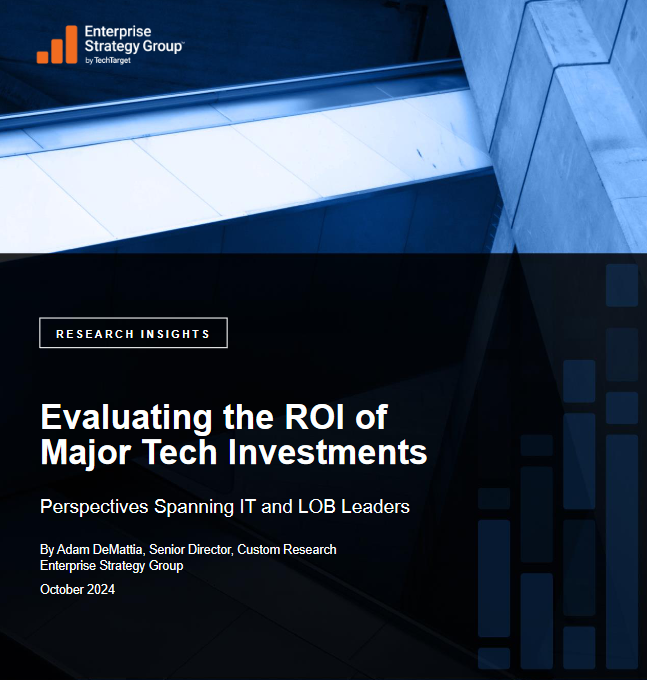- AWS Executive Insights›
- Finance›
- Redefining Tech ROI
Redefining Tech ROI: Uniting IT and Business Objectives
By: Chris Hennesey
Achieving alignment in technology investments
Despite economic uncertainties, organizations recognize that investing in technology is crucial for driving innovation and maintaining a competitive edge. Not all investments are created equal though. Some drive ROI immediately, while others may lag behind or underdeliver on expectations. To shed light on technology investment decisions, AWS partnered with TechTarget’s Enterprise Strategy Group to survey 1,000 senior IT and line-of-business (LOB) managers across 10 industries globally. The study sought to uncover which technology investments deliver the highest returns, which underperform, and why. You can read the full report on Evaluating the ROI of Major Tech Investments.
One of the most striking insights from this research was that, in an era when technology can make or break a company’s success, there is a clear lack of alignment between IT and business leaders on the value of technology initiatives. In fact, while the average organization made sizable investments in more than 10 different technology areas over the last 12 to 24 months, there was a significant perception gap between both groups regarding the return on those investments. This gap stems from how closely these groups are involved in decision-making and the actual use of the technology. Those more removed from the investment strategy or the technology’s implementation were less likely to report positive returns—emphasizing the need to align IT with business from the start.

This misalignment is cause for concern
It makes it difficult to agree on which technologies to prioritize and where to allocate resources, and can lead to underutilized or ineffective deployments. And it strains relationships between IT and business stakeholders. Bridging this divide is crucial for ensuring that technology investments align with broader business goals and deliver real impact across the organization. To that end, I want to share some of the approaches I’ve seen work for organizations in their effort to align IT with business and decision-makers while maximizing technology ROI.

Set realistic expectations with the business
Many organizations fall into the trap of setting overly optimistic payback periods for their technology investments, often expecting returns within 7-12 months. This short-term thinking can lead to rushed implementations and a focus on quick wins that overshadow significant long-term benefits. The reality is that many technology investments, particularly those that are transformative or complex, require more time to mature and deliver their full value.
To set and manage realistic expectations it can be helpful to:
- Bring IT and LOB stakeholders together to clarify objectives early, define success criteria together such as revenue increases and/or cost reductions, and build a shared roadmap to be delivered in smaller, manageable phases.
- Take a comprehensive approach to measuring ROI, looking beyond quantitative metrics like revenue and cost reduction, to include qualitative benefits like improved customer experiences and customer loyalty (and sometimes your customers are your lines of business users).

Build ongoing consensus
One common gap in technology investment planning is the lack of communication with other leaders in the organization to get input on current and future needs. Cross-functional collaboration ensures that investments are not only technically sound but also strategically aligned with business goals—a core part of IT strategy alignment.
To achieve the full value of investments, IT and business teams need to be engaged at all stages of the investment strategy and planning process, from ideation through to implementation and beyond. This helps clarify business priorities, jointly set objectives, make resource allocation decisions, and develop adoption strategies with input from end-users.
Unsurprisingly, the viewpoints of IT and LOB stakeholders may differ throughout this process. To effectively build stakeholder alignment, consider:
- Building a new social contract: Many decisions are “two-way doors” — ones where the implications are limited and the consequences are reversible. At Amazon, in those instances rather than getting stuck in the mud, we use a leadership principle called "disagree and commit" to hear everyone’s perspective and then collectively commit to a plan.
- Empowering rapid decision-making: It’s practically impossible to have 100% of data in hand before making a decision. Rather than waiting to have as much information as possible, Amazon leverages the "bias for action" leadership principle, typically acting with about 70% of the data in order to enable vigorous debate and accelerate decision-making. This works particularly well for decisions that are reversible and require less experimentation.

Invest in your people
Even the most advanced technology will fall short of its potential if staff lack the skills to utilize it effectively. Without proper training and support, employees may resist adopting new technologies, revert to old ways of working, or use only a fraction of a tool’s capabilities. Moreover, as technology evolves rapidly, continuous learning and skill development become essential. Organizations must foster a culture of ongoing learning to stay ahead of customer needs and competitive offerings.
To maximize the value of technology investments consider:
- Partnering with vendors to develop customized and comprehensive training programs and self-paced learning options. For instance, AWS Skill Builder has a wide range of programs for builders and executives regarding all facets of the cloud.
- Engaging leadership teams in learning sessions regarding new tools and technologies so they can be aware of what’s available to empower their teams, or what tools risk being brought into the organization as shadow IT.
- Aligning training with business objectives to show how new skills can drive business outcomes. For example, demonstrating how LOB employees can make the most of intelligent assistants by structuring queries correctly in order to boost their productivity and that of the business unit.

Implement continuous feedback and adjustments
The business landscape changes every day. The initial rationale for a technology investment may be different or no longer apply as time goes on. The way LOB employees use certain technologies may change. Or the needs that a given technology was intended to solve may evolve. Maintaining an up-to-date picture of how technology is being used and a mutual understanding between IT and LOB managers is an ongoing journey.
To maintain strong alignment across all levels of stakeholders over time, organizations should consider implementing:
- Open communication channels that encourage honest feedback about both successes and challenges in technology implementation and adoption, particularly from those using new tools. One tool we use at Amazon is Amazon Connections, a daily one-question survey for employees that enables us to quickly assess various aspects related to operations, technology, and people, among other topics.
- Regular review cycles with managers and senior leaders to assess the ongoing value and alignment of technology investments with business goals.
- Flexible investment approaches that enable resource reallocation based on actual outcomes and changing business needs.

Foster a culture of collaborative innovation
Achieving objectivity and aligning IT strategy with business strategy is an ongoing process. It requires continuous engagement, communication, and a willingness to adapt strategies based on real-world outcomes. Prioritizing alignment from the outset enables organizations to make more informed investment decisions, leading to better resource allocation, more effective implementations, and ultimately, stronger business performance. As technology continues to reshape the business landscape, those organizations that successfully implement business aligned IT strategy models and align IT with business at every level will be best positioned to thrive.
For detailed findings and additional insights, explore the full report on Evaluating the ROI of Major Tech Investments.


